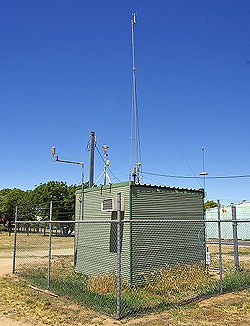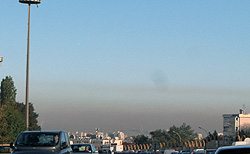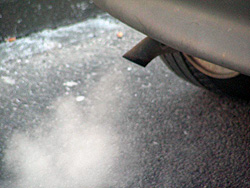Illness Costs of Air Pollution

Air pollution is having a serious effect on the health of the people of Ontario. The Ontario Medical Association has published research into these effects and their economic impacts. Annually, air pollution is estimated to cost Ontario more than $1 billion a year from hospital admissions, emergency room visits and absenteeism.
Some scientists have suggested that as the mean annual temperature increases in Ontario due to climate change, the formation of smog may be increasing. Smog is a complex mixture of pollutants and occurs under certain conditions. The chemical reaction that occurs in the atmosphere between sunlight, nitrogen oxides (NOx) and volatile organic compounds (VOCs), results in small particles in the air called particulate matter (PM) and ground-level ozone.
It is a myth that air pollution only affects people with asthma or pre-existing lung problems. Air pollution in general has an effect on the immune system of everyone. It can cause eye and nose irritation which dries out the protective membranes of the nose and throat and interferes with the body's ability to fight infection, increasing susceptibility to illness. Among the different types of air pollution, ground-level ozone is of particular concern. Even when ozone levels are low, everyone has some degree of loss of lung capacity.
Smog-related deaths are more often the result of cardiac (heart) causes than lung causes. This is of particular concern because many people with heart conditions are not aware of them.
Even in areas with relatively low levels of air pollution, public health effects can be substantial and costly. This is because effects can occur at very low levels, and there are a large number of people that potentially breathe such pollutants.
How are we doing?

The Ontario Medical Association has linked poor air quality to specific financial and health costs. The Association developed detailed estimates of the costs incurred during a single year (2005). They estimated that in Essex County (including Windsor), there were 260 premature deaths, 900 hospital admissions and 2,750 emergency visits associated with poor air quality in 2005. The results of their study also project increases in these numbers to the year 2026.
What is the City of Windsor doing to reduce illness associated with air pollution?
The City has begun to develop a heat alert and response system (HARS) with the aid and financial support of Health Canada. The effects of air pollution are made worse during extreme heat. Heat and humidity add to the stress on people's bodies, in particular, the heart and lung system, especially in those whose heart and lung systems are already compromised by a medical condition. HARS will provide residents of Windsor with the following:
- A way to identify when a heat wave is likely to happen and if it presents a health risk
- A response plan of activities that will help reduce the negative health impacts of extreme heat
- A public education program to help people make good decisions when there is an extreme heat event
Other initiatives by the City are intended to help reduce some of the causes of air pollution that can be influenced by local government. These initiatives all relate to reducing emissions from motor vehicle use and are each discussed elsewhere on this website under the following headings:
- Air Quality Health Index Indicator
- Ground Level Ozone Indicator
- Population density (making urban areas more compact)
- Commuting (reducing the use of motor vehicles for commuting)
- Trails (providing convenient options for making trips using a bicycle)
Much of the air pollution affecting Windsor comes from upwind sources, such as coal-powered electricity generating stations and industries and cities located in Michigan and the Ohio Valley. Second to these cross-border emissions, Windsor is also highly affected by emissions from transportation corridors. The Windsor-Detroit gateway is the busiest international trade corridor in North America. In 2005, over 16 million cars and trucks crossed the Windsor-Detroit gateway. The third major source of air pollution in Windsor is local transportation.
With regards to the City of Windsor's own vehicle emissions, an important first step was taken with the purchase of 18 hybrid electric buses. These buses represent an immediate conversion of 18 percent of Transit Windsor's fleet to hybrid technology. The new buses use significantly less fuel than regular buses and represent a highly visible pilot project that is expected to generate public interest and support for improving the efficiency of City's fleet of vehicles. As the new buses are put into operation and garner attention on City streets, the City's initiative might encourage private individuals and the business community to invest in hybrid technology as part of their own vehicle purchases.
Ultimately, Windsor's air quality is a regional problem that can only be addressed through engagement with other governments. The City of Windsor is partnering with other cities in South West Ontario to form a regional Clean Air Partnership based on a model used in the Toronto area. The objectives of the Clean Air Council are as follows:
- Leverage maximum financial, human and other resources towards our principles
- Facilitate collective, institutional and individual action through partnership
- Foster and build collaborations with and support sustainable, community-based efforts.
What can you do to reduce illness associated with air pollution?

Plan to reduce your exposure by being aware when smog levels are highest and watching for smog advisories. In addition to advisories announced by the media as part of local weather reports, you can get the latest information on air quality conditions in Windsor and other cities in Ontario by visiting the Air Quality Ontario website. Daily air quality index (AQI) values and forecasts are also available from the Ministry of the Environment, Conservation & Parks by calling toll-free 1-800-387-7768.
